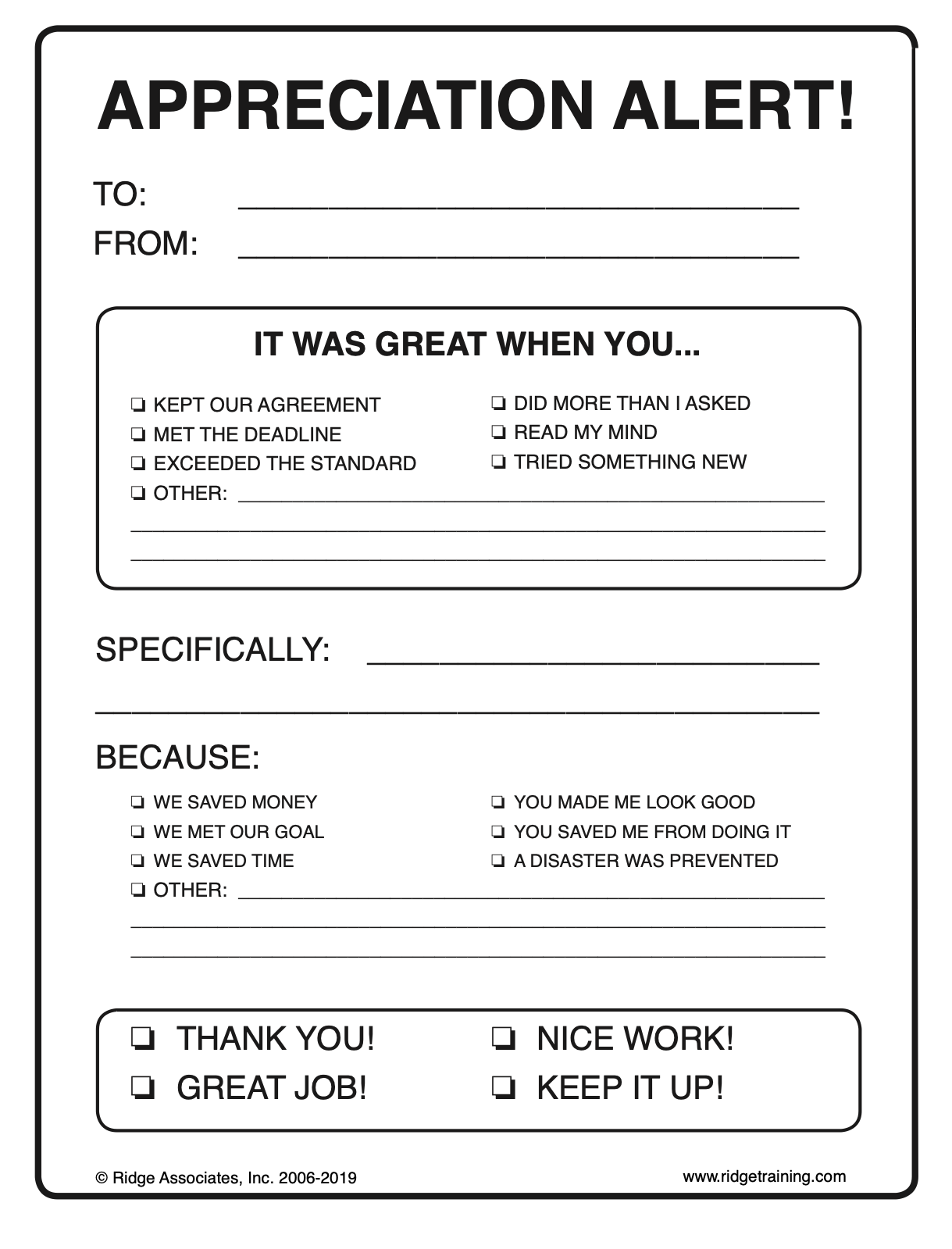Most of us aren’t great at appreciating others. Were better at seeing what’s wrong than what someone is doing well. That’s not a surprise; throughout our lives our teachers, coaches, bosses – even our loved ones! – are far more likely to point out our mistakes than our successes. Its natural for us to do the same. In informal polls I’ve done when leading workshops, people generally report a 5:1 ratio of receiving corrective-to-reinforcing feedback at work. As one manager said, “that’s if my boss is having a good day!”
Its funny because its true. Yet there’s growing evidence that reversing this trend is key to creating strong relationships and winning performance.
A longitudinal study by the Gottman Institute (which researches marriages) finds that consistent appreciation toward one’s partner is a fundamental difference between happy and stable couples and those headed toward divorce.
A recent study of educators found that “the higher the teachers praise-to-reprimand ratio, the higher the students on-task behaviour percentage.”
The Harvard Business Review reported that while focused corrective feedback can help performers improve, the “premise that leaders should provide more positive than negative feedback is correct.”
In three very different domains, research shows that recognition improves the strength of our relationships and our performance. What’s more, each of those studies identified a similar ratio of positive-to-negative comments needed to achieve those outcomes. Want to take a guess as to what that ratio is?
Yup, 5:1. According to the Gottmans, that “magic ratio” is what creates the richest relationships. In business and education, a 3:1 ratio will lead to improved performance although 5:1 leads to higher performance in these areas as well.
You may be reading this a little skeptically: sure, appreciation is a good thing, but five-to-one?! Even if it’s true, that’s a big change.
I thought so too. Then, on New Year’s Day, I made a bet with my 17-year-old daughter that I wouldn’t complain for the entire month of January. She was sure she was going to laugh all the way to the bank on January 2, but as the month ended, she grudgingly acknowledged I won. I used the bet as an opportunity to flip my ratio with her. She didn’t notice all of the increased appreciation, but on balance she said I was a lot nicer to be around (go figure). Not only that, I felt better! I almost blew it in the first few days, but some of the practices I developed helped me stay with it. They might help you if you want to try and flip your ratio too.
Notice the good things. Turns out, there’s a lot to appreciate if you look for it. Two tips:
Keep an appreciation journal. Some people keep a gratitude journal where they jot down three things they’re grateful for each day. Do the same with appreciation. At the end of your work day, write down three things others did that were in some way positive. The actions don’t have to be big and you don’t have to tell the people who did them; you’re simply training your brain to tune into the positive more often. This process took me less than five minutes a day. As a side benefit, I stopped sweating a lot of the small stuff that I found annoying. In the bigger picture of appreciation, the little things remain little.
Focus on behaviors and specifics: Instead of “Jim ran the meeting well,” think about what well means to you: Did Jim keep the discussion on track? Involve others? Check off the agenda items? Training yourself to be specific will help when you’re ready to actually offer acknowledgement.
Say what you saw. At first I shared my appreciation with my daughter a day or so after the behavior occurred. As I got better at noticing behaviors in the moment, I offered it right away. It gets easier as you go.
Don’t expect appreciation for your appreciation. This almost tripped me up. Sometimes my daughter dismissed my recognition or said nothing in response. In my mind Id hear myself say “you’re welcome!” with more than a little sarcasm. As the month went on her “whatever, dad, no big deal” became a “thanks dad.” My “you’re welcome!” became “you’re welcome.”
Don’t not say the corrective. I didn’t go 155-and-0 for the month; there were things I said that were corrective too. What I found is that by staying with specific behaviors, my frustration didn’t leak out as it has been known to do. That made it easier for her to hear and respond to as well.
I know this is a personal example, not a work one. You might want to start there too! It’s not like our families feel overwhelmingly appreciated on a daily basis. In some ways appreciating our loved ones may be easier, in some ways harder. The important things is you’re training your brain to adjust what you notice and acknowledge. If you stay with it, what you do at home will spill over to work and vice versa.
At its best, recognition should be fun to receive and fun to give. If you need a little help, we put together the following Appreciation Alert to add a little levity to the practice of recognizing others. Click on the image to download.


Leave A Comment